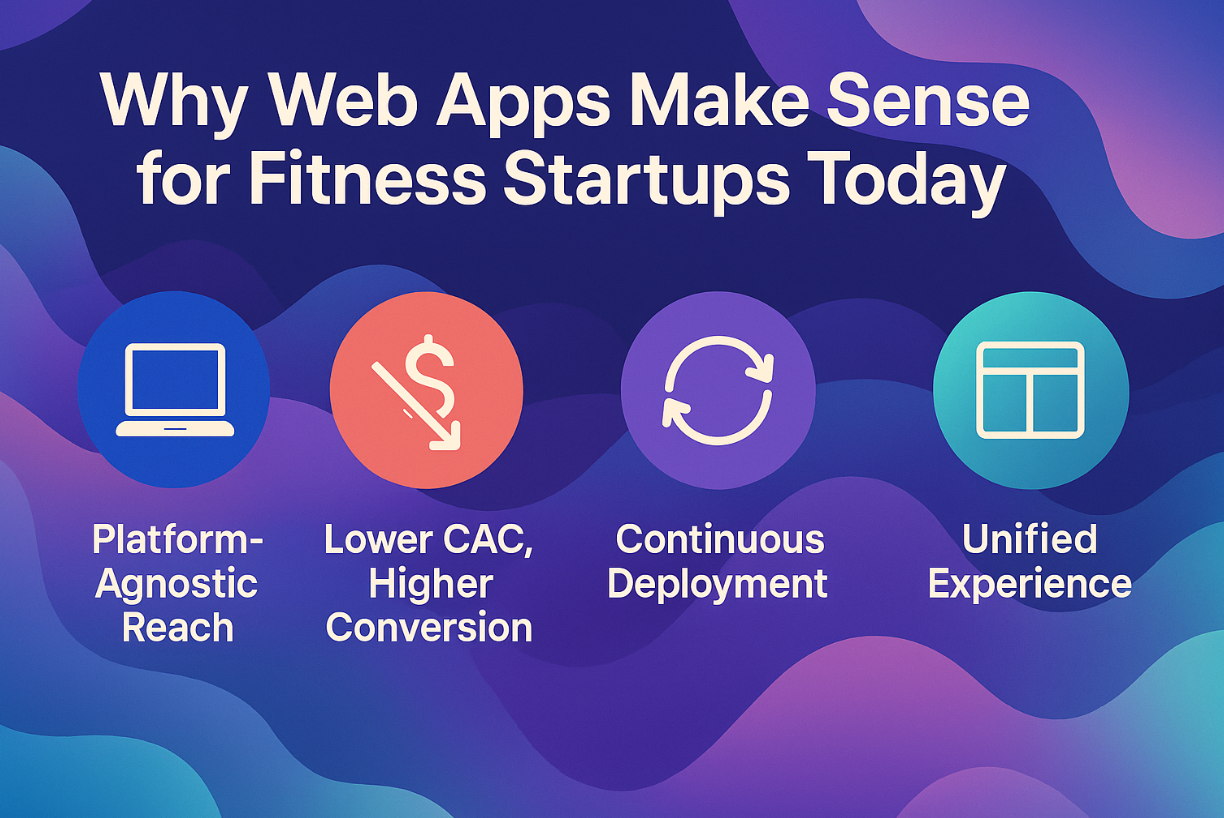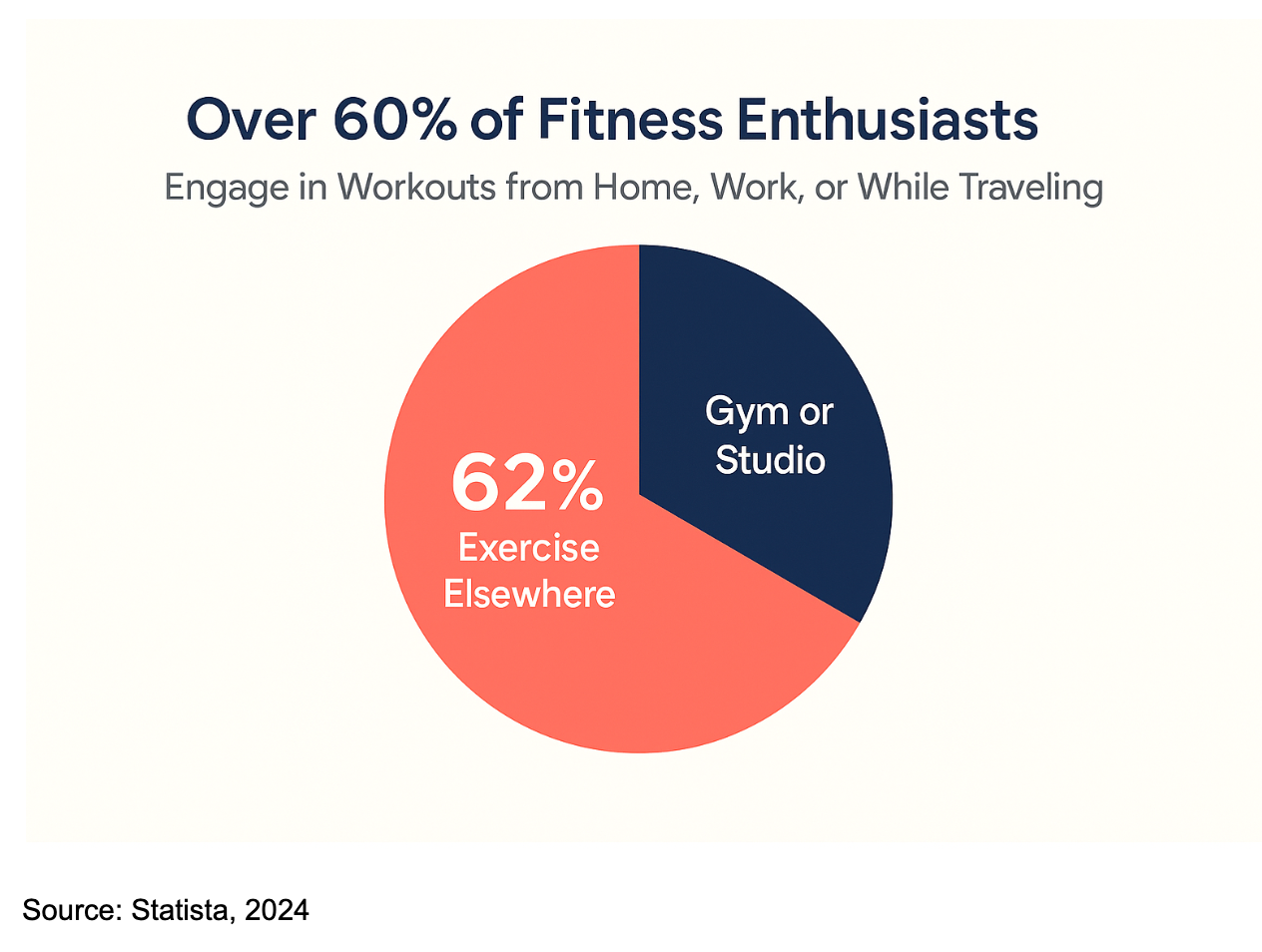Why Web Apps Are the New Frontier for Fitness Startups

Fitness has evolved beyond location—it now lives where the user is. More than 60% of fitness enthusiasts in the U.S. now engage in workouts from home, at work, or while traveling, demanding platforms that deliver speed, personalization, and flexibility across every device (Statista, 2024). As expectations rise, so does the need for seamless digital experiences that align with varied routines and schedules. In the race to engage fitness users across devices and demographics, Progressive Web Apps (PWAs) are fast becoming the go-to infrastructure for modern fitness startups. Combining the reach of the web with the native-like power of mobile, opting for web application development offer a future-proof foundation that maximizes agility, minimizes cost and accelerates scale. Below are the four key reasons they are not just viable – but strategic.
While native mobile apps have powered the fitness revolution so far, web apps are quickly redefining the playing field. Their cross-platform accessibility, fast deployment, and reduced development overhead make them an ideal choice for fitness startups looking to scale intelligently and serve wider audiences.
In this blog, we explore:
- Why web apps are gaining momentum in the fitness ecosystem
- How do they solve key challenges for both users and developers
- Their long-term strategic benefits for scalability, UX, and innovation
- Examples of companies using web apps to build strong, flexible fitness products
Let’s examine why web apps are shaping the future of connected fitness—and what startups can do to lead the charge.

Source: Statista, 2024
The Evolution of Fitness Tech: From Dumbbells to Dynamic Platforms
Digital fitness has come a long way from step counters and calorie calculators. In 2024, the industry surpassed $18 billion in global value, with projections placing it at over $30 billion by 2027 (Statista). At the center of this growth are platforms that integrate on-demand content, AI coaching, wearable syncing, and social features—many of which are now delivered through responsive, high-performance web apps.
What’s changed? Advances in front-end frameworks (React, Next.js), backend scalability (Node.js, Firebase), and edge delivery (Vercel, Cloudflare) have enabled the web to support immersive, app-like experiences without the cost or friction of app store dependencies. For startups, this unlocks faster iteration cycles, broader reach, and better control over user engagement.
Why Web Apps Make Sense for Fitness Startups Today
In the race to engage fitness users across devices and demographics, Progressive Web Apps (PWAs) are fast becoming the go-to infrastructure for modern fitness startups. Combining the reach of the web with the native-like power of mobile, web apps offer a future-proof foundation that maximizes agility, minimizes cost, and accelerates scale. Below are the four key reasons they are not just viable—but strategic.

1. Platform-Agnostic Reach with PWA Advantage
Web apps built with modern frameworks (like Next.js, React, or Vue) offer responsive UI across screen sizes—from smartphones to tablets to smart TVs—right out of the box. Progressive Web App (PWA) capabilities further enhance this by enabling:
- Home screen installability (with service workers)
- Offline functionality (via IndexedDB and Cache API)
- Push notifications (via Firebase or Web Push APIs)
This device-agnostic footprint means your app can be accessed instantly without app store dependency, meeting users in high-intent moments—like checking a workout schedule on their desktop at work or launching a quick HIIT session on their phone at home.
For startups, this translates into reduced time-to-market and a broader initial user base without needing multiple native builds.
2. Lower CAC, Higher Conversion Across the Funnel
With native apps, the marketing journey often breaks between click and install. According to Branch.io, the average mobile app install-to-action rate is just 26%, with high drop-offs due to storage issues, login friction, or long onboarding flows.
Web apps eliminate this friction:
- No download barrier — sessions launch immediately after clicking an ad or link
- Lightweight asset loads — optimized JS bundles and lazy-loaded content reduce wait times
- Linkable screens — direct users to personalized landing pages (e.g., “Try Our 7-Day Yoga Program”)
Fitness brands that optimize landing pages within web apps see 25–40% higher conversion rates from paid channels, especially during product launches, seasonal promotions, or influencer campaigns.
3. Continuous Deployment & Experimentation at Scale
Unlike native apps—where updates are gated by App Store and Play Store reviews—web apps deploy in real-time, giving startups the freedom to:
- Roll out UX experiments (via LaunchDarkly or custom feature toggles)
- Monitor real-time behavior metrics (using PostHog, Segment, or GA4)
- Iterate on feedback within hours, not weeks
For early-stage teams, this CI/CD velocity means tighter feedback loops, faster A/B test iterations, and quicker validation of core product assumptions (e.g., “Will users finish workouts if we add streak-based gamification?”).
Infrastructure powered by Vercel, Netlify, or Firebase Hosting supports atomic deploys and rollbacks, making dev pipelines lean, secure, and fast.
4. Backend Integration with Full-Stack Efficiency
Modern web apps support robust capabilities that go far beyond static content delivery. With the help of GraphQL APIs, serverless functions, and event-driven backends, fitness startups can build dynamic, personalized, and deeply integrated experiences. Examples include:
- Workout builders that auto-generate routines based on user goals, preferences, and injury history
- Habit trackers with real-time sync (via WebSockets or Firestore)
- Performance dashboards powered by analytics layers like Chart.js, D3.js, or Supabase Realtime
- Video delivery through CDN-backed platforms like Mux or Cloudflare Stream
Moreover, with cross-platform authentication (Auth0, Firebase Auth) and secure payment flows (Stripe Checkout, Razorpay Web SDKs), startups can manage subscriptions, user profiles, and engagement journeys using a single backend logic layer.
This unified architecture drastically reduces code duplication, simplifies QA, and enables resource-constrained teams to move faster without compromising quality or personalization.
Challenges Web App-Based Fitness Startups Must Navigate
While web apps unlock speed and reach, they also bring unique technical and strategic challenges.
1. Performance on Low-End Devices
Fitness platforms often involve media-heavy content like HD workout videos or 3D animations. Optimizing performance on low-end devices or flaky connections requires thoughtful asset compression, lazy loading, and CDN-based delivery strategies.
2. Limited Hardware Access
Unlike native apps, web apps face constraints when accessing device sensors (like accelerometers or Bluetooth heart rate monitors). Progressive enhancements and Web APIs are improving, but use cases that depend on deep hardware integration may still require hybrid approaches.
3. Data Privacy & Compliance
With fitness data often crossing into health territory, startups must ensure HIPAA compliance (for U.S. users), secure data encryption, and transparent consent management—especially when handling biometrics, geolocation, or medical history. Conducting thorough web application testing can help identify vulnerabilities early, ensuring data remains protected and users maintain trust in your platform.
4. Engagement Without Push
Web apps traditionally lacked native push notifications—essential for engagement in fitness journeys. However, modern browsers now support web push APIs, allowing startups to nudge users about goals, streaks, and live sessions. Still, adoption varies by OS and user permissions.
What the Future Looks Like for Web-First Fitness Platforms
The next wave of web apps in fitness will move beyond basic streaming and tracking. With AI, APIs, and personalization converging, here’s what’s coming:
- AI-Powered Coaching: Real-time feedback based on webcam posture analysis or wearable data streamed via Bluetooth Web APIs.
- Adaptive Workouts: Sessions that dynamically adjust reps, intensity, and rest based on user energy levels and past performance.
- Voice-Activated Interfaces: Hands-free interaction via Web Speech API, enabling users to switch exercises, pause timers, or change intensity mid-session.
- Gamification Layers: Leaderboards, streaks, and social challenges integrated directly into the web interface to boost habit formation.
- Integrations with Medical Systems: For wellness-focused platforms, secure links to EHR systems could turn web fitness apps into light-touch healthcare tools.
As these capabilities mature, web apps will not only match native performance but set new standards for what digital fitness can feel like.
Web-First Fitness App Development: 3 Emerging U.S. Tech Companies to Watch
1. GeekyAnts Inc., San Francisco, USA
Specialization: Cross-platform fitness apps, React Native, Next.js, AI dashboards
Clutch Rating: ★ 4.9/5 (100+ verified reviews)
With nearly 20 years of engineering leadership, GeekyAnts has emerged as a go-to partner for scalable web-first fitness app solutions. Their expertise spans frontend performance, intelligent UX, and real-time functionality—making them a preferred choice for wellness brands looking to build fast, adapt quickly, and scale globally.
Web Fitness Capabilities:
- AI-powered workout personalization engines with posture correction
- Live-streaming classes with chat overlays and session analytics
- Modular component libraries for faster rollouts
- Deep integrations with APIs from Garmin, Stripe, AWS, and wearable ecosystems
Why They Stand Out:
Rapid prototyping, clean code architecture, and proven ability to launch MVPs in weeks across devices make GeekyAnts the top pick for D2C and B2B fitness ventures.
For more information, reach out to GeekyAnts Inc at their U.S. office located at 315 Montgomery Street, 9th & 10th floors, San Francisco, CA 94104. They can be contacted via phone at +1 845 534 6825 or by email at [email protected]. For more details about their services and expertise, visit their official website at www.geekyants.com/en-us.
2. Zova Web Studio, Denver, Colorado
Specialization: Frontend optimization, fitness SaaS for lean teams
Clutch Rating: ★ 4.5/5
Zova Web Studio brings agility to the fitness tech space with a sharp focus on web performance and UI optimization. Known for delivering lightweight, content-rich platforms, Zova enables startups to get to market faster—without sacrificing experience or scalability.
Strengths:
- Performance-optimized streaming for mobile web
- Accessible UX with low-load onboarding flows
- SaaS-ready dashboards with real-time engagement tracking
3. FlexFrame Digital, Austin, Texas
Specialization: Gamified wellness apps, PWA development
Clutch Rating: ★ 4.6/5
FlexFrame Digital builds immersive fitness experiences centered around gamification and user engagement. Their expertise in progressive web apps (PWA) and habit-forming UX makes them ideal for brands targeting younger demographics or community-driven models.
Core Offerings:
- Gamified challenges with real-time leaderboards
- Habit loops and achievement systems
- AI-enhanced video tutorials with overlay guidance
Conclusion
Web apps have quietly become the backbone of modern fitness innovation—powering scalable, responsive, and personalized platforms without the bloat or barriers of native development. For startups, they offer a strategic edge: faster go-to-market, lower CAC, and unified product architecture built for iteration. As AI, wearables, and gamification evolve, the web will no longer be the fallback—it will be the frontier. The startups leading with web-first thinking today are building the digital fitness ecosystems of tomorrow.



